#Mashed potatoes and parsnips
Text
Mashed potatoes and parsnips

An old-fashioned potato masher works perfectly for me.ĭid you make this recipe? Please leave a ⭐️⭐️⭐️⭐️⭐️ rating in the recipe card and/or a review in the comments section at the bottom of the page. Yes, you could use an electric mixer for the potatoes, but I often find that I don’t get the consistency I like with the mixer.But we want to put a spin on this classic simple dish, and thought about the under-utilized parsnips. The cast iron just conducts the heat so much better. Mashed potatoes are a staple at the Thanksgiving table. With the lid on my cast iron Dutch oven, the potatoes cook faster than a traditional pot.You can find nutritional yeast at Trader Joe’s or Bragg’s nutritional yeast is available in most well-stocked grocery stores.I love this almond milk because it only has two ingredients: filtered water and almonds. Ingredients 2 cups chopped & peeled parsnips 2 cups cubed & peeled baking potatoes cup half-and-half or non dairy substitute 2 teaspoons butter or. CUT potatoes into quarters and parsnips into similar-size pieces. I used Elmhurst unsweetened almond milk.When/if reheating the potatoes, you may need to stir in a little extra almond milk.Put them into a large pot, cover them with cold water, and add a large pinch of salt. Drain, return vegetables to the pot, and dry over medium heat for. Directions Peel and cut the potatoes and parsnips into even sized pieces. This recipe was originally published on Novembut has been updated with new photos and recipe tips to improve the reader experience. Boil potatoes and parsnips in a large pot of salted water until tender, 1015 minutes.

0 notes
Text


Root Vegetable Mash with Miso Maple Butter (Vegan)
#vegan#lunch#dinner#celeriac#parsnips#purée#mashed potatoes#vegan butter#maple syrup#miso#garlic#plant milk#sesame seeds#sea salt#🤍
119 notes
·
View notes
Text

Roast beef, roasted vegetables, potatoes, carrots, parsnip, mashed swede, broccoli, cauliflower cheese, gravy, Yorkshire pudding…pint of cider…..
#roast dinner#roast beef#roasted vegetables#roast potatoes#roasted carrots#parsnips#mashed swede#broccoli#cauliflower cheese#gravy#yorkshire pudding#pint of cider#me#mine
4 notes
·
View notes
Text
Sometimes you have friends come over so you make a Sunday roast!


#sunday roast#wine#brussel sprouts and bacon#carrots and parsnips#Yorkshire pudding#gravy#roast beef#mashed potatoes#queer#food porn
4 notes
·
View notes
Text
Parsnip and Potato Mash

Another delicious side, perfectly comforting on a grey and wet Winter day, this Parsnip and Potato Mash is both tasty and hearty.
Ingredients (serves 2):
2 small Parsnips
3 medium Potatoes
½ teaspoon coarse sea salt
3 cups water
2 tablespoons unsalted butter
nutmeg
1/3 cup semi-skimmed milk
Thoroughly rinse and scrub Parsnips; peel, if necessary. Peel and halve Potatoes.
In a large saucepan, combine Parsnips, Potatoes, coarse sea salt and water. Bring to a slow boil over medium heat, and simmer until Parsnips are tender, about 20 to 25 minutes.
Drain Parsnips and Potatoes thoroughly, stir in butter and grate in about ¼ teaspoon nutmeg. Mash roughly with a potato masher.
Return over a low flame, and gradually stir in the milk.
Serve Parsnip and Potato Mash hot, as a side to grilled white sausages, Duck, fish or poultry.
#Recipe#Food#Parsnip and Potato Mash#Parsnip and Potato Mash recipe#Parsnip Mash#Potato Mash#Potato Mash recipe#Parsnips#Garden Parsnips#Potatoes#Garden Potatoes#Garden Vegetables#Kitchen Garden#Kitchen Garden Harvest#Growing Vegetables#Coarse Sea Salt#Water#Nutmeg#Butter#Milk#Easy recipe#5 Ingredients or Less#Side#Side Dish#Side recipe#Side Dish recipe#Salad and Side
0 notes
Text
Have y'all ever attempted to plan a vegetarian holiday meal where two out of the three people in attendance are picky eaters because damn
#zombie thoughts#like if i weren't vegetarian it would probably be easier#because the no-go list for one of the picky eaters includes mushrooms and beans (as well as white potatoes; sweet potatoes are okay)#and the other picky eater doesn't like brussels sprouts or asparagus or cranberries (among other things)#i suppose i could have sweet potato mash as a side but i still need a second side and wtf am i going to serve for my main#as long as i don't have to eat meat i'm fine with pretty much everything except lima beans (fuck lima beans)#i wanted to get away from veggie wellington this year but i found one that has parsnips and sage so i may just do that
0 notes
Photo

Mashed Parsnips
Similar to how mashed potatoes are made, parsnips are cooked in milk until fork-tender before being mashed with butter and thyme until creamy and smooth. 1/4 cup butter, 5 cups whole milk, 1 teaspoon dried thyme, 1 teaspoon salt or more to taste, 1/2 teaspoon ground black pepper or more to taste, 10 parsnips peeled and cubed
0 notes
Photo

Vegetables - Mashed Parsnips
Parsnip mash is made very similarly to mashed potatoes by boiling in milk until tender, then mashing with butter and thyme until smooth and creamy.
0 notes
Text
Mashed Parsnips

Parsnip mash is made very similarly to mashed potatoes by boiling in milk until tender, then mashing with butter and thyme until smooth and creamy.
0 notes
Photo

Mashed Parsnips
Parsnip mash is made very similarly to mashed potatoes by boiling in milk until tender, then mashing with butter and thyme until smooth and creamy.
0 notes
Text
DON'T FORGET THE VEGETABLES
Brussel Sprouts Trim the sprouts and place in a saucepan of boiling water with a little salt. Reduce to a simmer and cook for 5-8 minutes depending on the size of the sprouts. While they are cooking, brown some diced bacon in a little olive oil.

View On WordPress
#Braised Celery#Brussel Sprouts#Christmas#Christmas Dinner#Happy Christmas#Market#Mashed Potatoes#Merry Christmas#Parsnips#Red Onions#Roast Potatoes#Roasted Carrots#Vegetables#William Murphy
0 notes
Text


Vegan Shepherd's Pie
#vegan#dinner#shepherds pie#british cuisine#celeriac#mushrooms#turnips#parsnips#carrots#garlic#miso#vegan sausage#thyme#rosemary#worcestershire sauce#mashed potatoes#potato#black pepper#sea salt#💜
53 notes
·
View notes
Link
We love a good parsnip side here on the blog, and I thought this recipe would be the perfect pair for the leek, potato, and chive cakes we made for dinner the other night.
I halved this using vegan margarine and Remus’s whole milk. The difference in milk might have been what made the texture of this so odd, but I think the real culprit was my mistake in leaving the milk on the heat for too long, to the point that it might have curdled slightly.
As a result, this didn’t quite get the ‘whipped texture’ I was looking for; if I’m being honest, it was more gloopy than anything else. The flavor was all there, that’s for sure, but the texture kind of took away from that deliciousness, though not entirely.
But between that and the mediocrity of the cakes and accompanying sauce, this was only a so-so dinner, which is honestly rather a rarity for us. But then again, I suppose it’s good to be brought to earth like this every now and then.
0 notes
Text
Of parsnips and parsnip soup
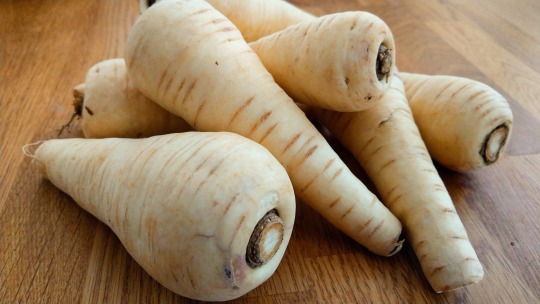
So the question of parsnips, and particularly parsnip soup, came up secondary to this quote from an interview with Terry Pratchett. (Thanks to @captainfantasticalright for the transcription.)
Terry: “You can usually bet, and I’m sure Neil Gaiman would say the same thing, that, uh, if I go into a bookstore to do a signing and someone presents me with three books, the chances are that one of them is going to be a very battered copy of Good Omens; and it will smell as if it’s been dropped in parsnip soup or something in and it’s gone fluffy and crinkly around the edges and they’ll admit that it’s the fourth copy they’ve bought”.
And when @petermorwood saw this, he immediately reblogged it and added four recipes for parsnip soup.
These kind of surprised some folks, as not everybody knew that parsnips were an actual thing: or if they were, what they looked like or were useful for.
The vegetable may well be better known on this side of the Atlantic. (And I have to confess that as a New Yorker and Manhattanite, with access to both great outdoor food markets and some of the best grocery stores in the world, I don't think that parsnips ever came up on my personal radar while I was living there.) So I thought I'd take a moment to lay out some basics for those who'd like to get to know the vegetable better.
The parsnip's Linnaean/botanical name is Pastinaca sativa, and in the culinary mode it's been around for a long time. It's native to Eurasia, and is a relative to parsley and carrots (with which it's frequently paired in the UK and Ireland). The Romans cultivated it, and it spread all over the place from there. Travelers who passed through our own neck of the woods before the introduction of the potato noted that "the Irish do feed much upon parsnips", and in the local diet it filled a lot of the niches that the potato now occupies.
You can do all kinds of things with parsnips. The Wikipedia article says, correctly, that they can be "baked, boiled, pureed, roasted, fried, grilled, or steamed". But probably the commonest food form in which parsnips turn up around here is steamed or simmered with carrots and then mashed with them: so that you can buy carrot-and-parsnip mash, ready-made, in most of our local grocery chains.
It also has to be mentioned that most Irish kids have had this stuff foisted on them at one point or another, and a lot of them hate it. (@petermorwood would be one.) I find it hard to blame anybody for this opinion, as one of the parsnip's great selling points—its spicy, almost peppery quality—gets almost completely wiped out by the carrot's more dominant flavor and sweetness.
Roasting parsnips, though, is another matter entirely. They roast really well. And parsnip soups are another story entirely, as it's possible to build a soup that will emphasize the parsnip's virtues.
So, to add to Peter's collection, here's one I made earlier—like yesterday afternoon, stopping the cooking sort of halfway and finishing it up today.
I was thinking in a vague medioregnic-food way about a soup with roasted bacon in it, but not with potatoes (as those have been disallowed from the Middle Kingdoms for reasons discussed elsewhere. Tl;dr: it's Sean Astin's fault). And finally I thought, "Okay, if we're going to roast some pork belly or back bacon, then why not save some energy and roast some parsnips too? The browned skins'll help keep them from going to mush in the soup."
So: first find your parsnips. I used four of them. You peel them with a potato peeler...

...sort of roughly quarter them, the long way...

...then chop them in half the short way, toss them in a bowl with some oil—olive oil, in this case—spread them on a baking sheet, and season them with pepper, coarse salt, and some chile flakes. (I used ancho and bird's-eye chile flakes here.)
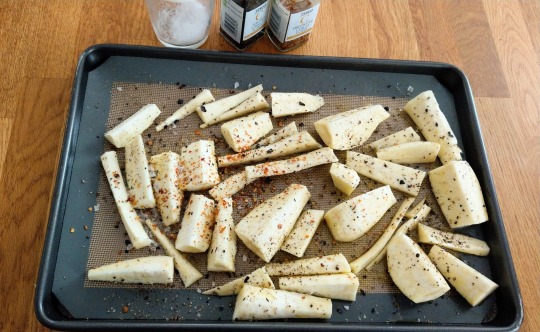
These then went into the oven for about half an hour, and came out like this.

While that was going on, I got a block of ready-cooked Polish snack bacon out of the freezer.

On its home turf, this is the kind of thing that turns up (among other ways) sliced very thin on afternoon-snack plates, with cheeses and breads. But we like to score it and roast it to sweat some of the fat out, and then use it in soups and stews and so forth.
So I scored this chunk on most of its sides, browned it in a skillet, then shoved the skillet into the oven for twenty minutes or so. Here's the bacon after it was done.

While it was cooking, I made about a liter of soup stock from a couple of stock cubes. If you can get pork stock cubes, they'd be best for this, but beef works fine.

This then went into the pot and was brought up to just-boiling while the bacon and the parsnips were chopped into more or less bite-sized chunks. After that, the meat and veg were added to the pot and the whole business was left to simmer for a couple of hours while I went off to do some line editing.
Finally I turned it off and left it on the stove overnight (our kitchen is quite cool, it was in no bacteriological danger from being left out this way) and then finished its simmering time around lunchtime today.
And here it is. (...Or was. It was very nice.)
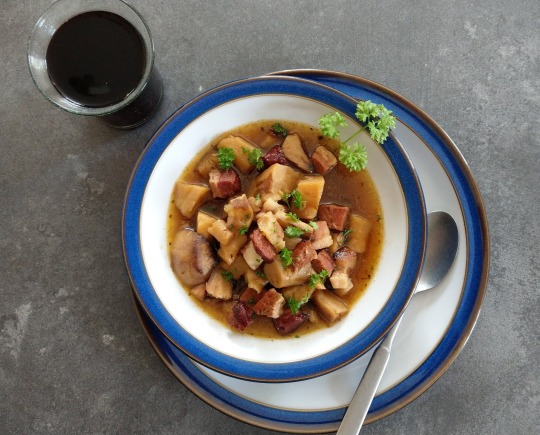
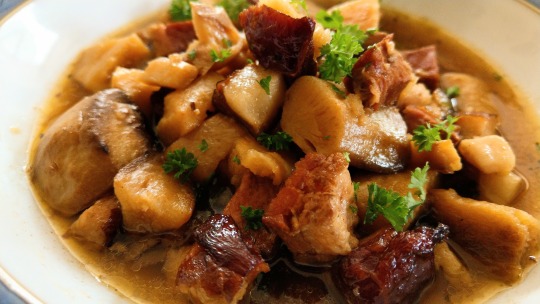
...Anyway, this is only one of potentially thousands of takes on parsnip soup. Recipes for more robust versions—based on mashed parsnips and more vegetables, or different meats—are all over the place.
Meanwhile, as regards how much damage this soup could do to your copy of Good Omens if you dropped yours in it, I'd rate this at about 5 damage points out of 10. ...Call it 5.5 if you factor in the chiles. Soups along the boiled-and-mashed-parsnip spectrum would probably inflict damage more in the 7.50-8.0 range. But your results may vary: so I'll leave you all to your own experimentation.
394 notes
·
View notes
Text
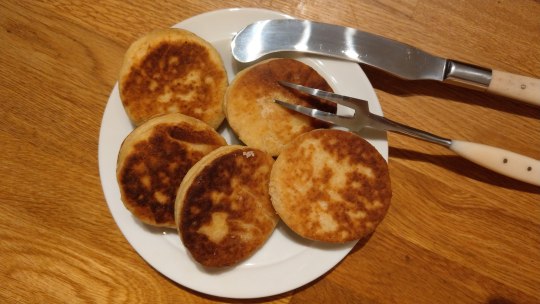
As mentioned more than once, @dduane's Middle Kingdoms don't have potatoes. A frequent alternative is parsnips, and the fried cakes in that photo are the result of an experiment done earlier this week to see if parsnips can substitute for potatoes in our always-reliable potato cake recipe.
Yes, they can!
*****
Here's @dduane's recipe.
First peel three regular-sized parsnips. then top and tail them.
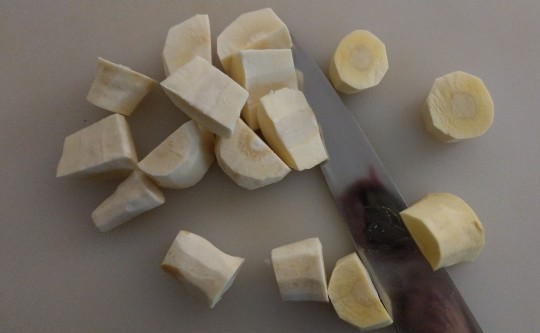
Chop them into chunks and boil them in about 2 pints (1 litre) of water.
Drain them and return to the pan: let them steam dry. Then, while still hot, mash them well with a hand masher and allow to cool completely.
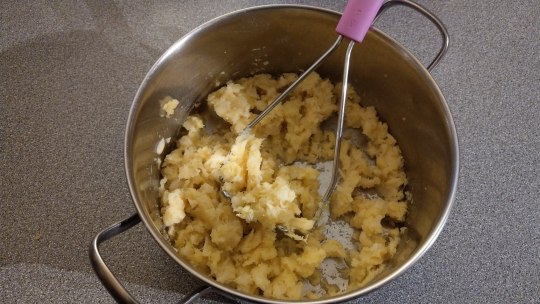
As mentioned further down, parsnips retain more water than potatoes even after steam-drying, so DON'T use a food processor or other power appliance for mashing or the result will be parsnip wallpaper paste. However, a processor is ideal for the rest of the recipe.
Put 2 cups (500g) all-purpose flour and ½ tsp salt into the processor bowl, blip the pulse switch to combine them then add 1½ tsp baking powder and blip again.
Now add 3 tablespoons butter and blip the pulse switch until the butter is completely worked in and the whole mixture has a cornmeal-y texture.
Now add the cooled mashed parsnips.
Process with the flour mixture, pulsing at first, then continuously, until the mixture comes together in a dough.
(If yours behaves the way our recipe did, no additional liquid should need to be added. The parsnips hold onto a surprising amount of water even after being steamed dry.)
Flour a work surface, roll the dough out about 1/3 inch (1 cm) thick, and use a sharp biscuit cutter to cut out into rounds. Then heat cooking oil in a frying pan to medium heat and put five or six of the cakes into the hot oil.
Fry until the cakes begin to rise a little (usually 4-5 minutes) and are going golden brown Turn and fry the cakes on their other sides for another 4-5 minutes. Test one for doneness: if necessary, turn the cakes once more and give them another 5 minutes or so.
Then cook the rest of the cakes in the same way. When they're done cooking, drain on paper towels until they're cool. Eat fresh or, to keep them, put them in a biscuit tin or other airtight container.
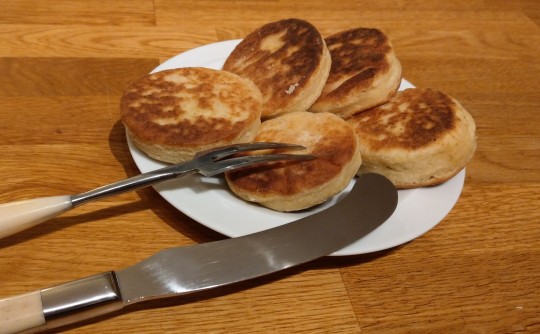
They'll keep for a few days. The parsnip flavor mellows somewhat the day after you bake them.
Like their potato-cake cousins, they're very good split, toasted, buttered and topped with a slice of cheese or (and) salami. They also shine as an accompaniment to bacon or sausages; give the parsnip cakes a brief re-fry in the fat left from frying these, then serve alongside the fried meats, dressed with a splash of Worcester or HP sauce and maybe a dotting of Tabasco or similar.

Our next experiment will be to make this recipe with the addition of some crumbled crispy bacon, grated cheese, grated onion or a combination of same.
The experiment after that will be to see if this can become parsnip bread in the same way as Irish potato farls. I think it will... :->
483 notes
·
View notes
Text
Try to learn about the old foods
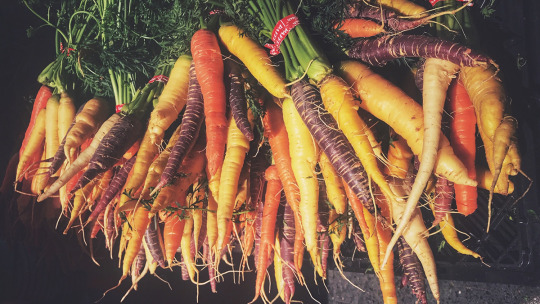
I have most recently started to meal prep, with making a lot of foods and putting them in the freezer. This ended up allowing me to buy the foods in bulk from the local market. And, well... This allowed me to eat some of the foods that the supermarket does not have.
We do have a bit of a problem. And that problem mostly is that we got our food kinda messed up. Because people have lost the connection to the food they eat. But also because of colonialism.
The big thing that happened is, that we lost contact with most local foods. No matter where I go in the "first world nations"... The foods offered to me in the supermarkets are the same - and they also look the same.
This means that a lot of people have no real idea, what foods came from where in the world - but also do not know half of the foods that originated with where they are from, because they are not easily available.

Tomatoes are an example. Not only did historical tomatoes look and taste very differently from the tomatoes we eat today, but obviously... they came from the Americas. So they are not a food that originated with Europe and was not widely available in Europe until the 1600s. While, yes, the first tomates came here more than a hundred years earlier... it took a while for them to catch on.

This is parsnip. Another root vegetable that was commonly eaten in Europe for most of history. It has a more intensive taste than the usual carrot - but is also not that different from it, when it comes to consistency and how it is going to cook.

This is fennel. You might know fennel seeds as a spice or something you might drink as a tea. But the rest of the plant is edible, too, and a surprisingly strong flavored vegetable. It also is very crunchy and makes a really great addition to salads. But it is often not really sold in many places.

This is the Jerusalem Artichoke, another vegetable that originates within the Americas. To be exact, this is the root of a kind of sunflower. It got its name for being very similar in taste and tecture to the Artichoke. I honestly do not know, though, why it is called "Jerusalem Artichoke", because it does not have anything to do with Jerusalem.
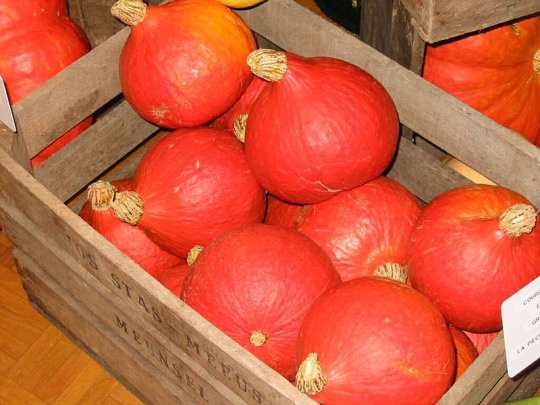
The Potimarron is a kind of squash that - like basically all other forms of squash - originates in the Americas as well. It has a very nutty flavor. In Europe it was very popular in France for a long while, hence the french name. It has tons of meat and really makes for great stews!

This is a rutabaga, which originates from somewhere in northern Europe. We do not really know from where. All we know is, that it was a Swedish botanist who cultivates the form we still eat to this day in the 1620s. Which is why it is also called the "Swedish turnip". It does taste like a more bitter carrot, but makes really good addition to stews or can be served stamped.
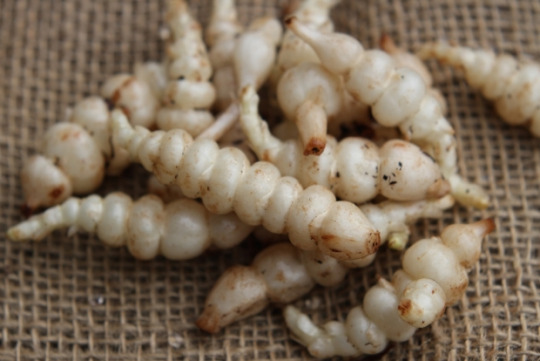
This is the Chinese Artichoke and another root vegetable, that as the name suggest originates from China. It was cultivates in China in the late medieval period and has later made its way to Europe, especially France. It has a really sweet and nutty taste and can be eaten raw or in salads. Though there are dishes mashing the vegetable, too.

These are tigernuts, a vegetable that has been around forever. It originates in southern Europe, southern Asia and northern Africa. It is a dried fruit, with a sweet and earthy taste and it is known a lot in Spanish cuisine, but also in the cuisine of southern Asia.

Yacon is a root vegetable that originates with Peru, where it is still eaten, while the rest of the world mostly forgot about it. Well, except Japan, where it is currently getting more and more popular. It is a vegetable, but it has a very fruity taste.
I could now go on and name more vegetables from all around the world that were once grown and fed people, but got forgotten more and more in favor of the very limited diet made up of potatoes, corn, potatoes, peppers, cucumber, onion and tomatoes, that is basically what you will get to eat in most places.
And... Well, the thing about it is that... It is not really a good thing that we grow the same stuff everywhere. It is not good for us and it is not good for the environment. It is not good for those foods, either.
I really wish people would try and eat more of the stuff that originates with their region. And that they would eat the not-so-perfect looking foods as well. Because it is gonna be more sustainable in the end.
#solarpunk#food#vegetables#fruits#farming#agriculture#history#food history#sustainable living#sustainability#colonialism
336 notes
·
View notes